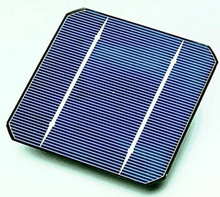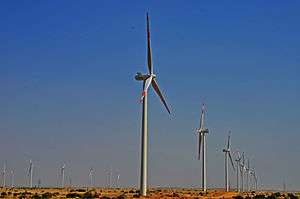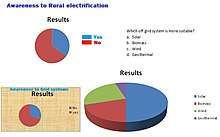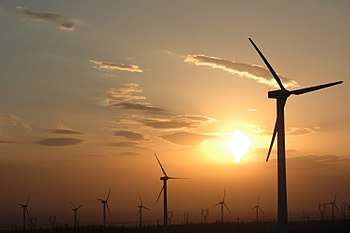Smart villages in Asia
Concept of Smart villages is a global modern approach for off-grid communities. Vision behind this concept is to assist the policy makers, donors and socio-economic planner for rural electrification worldwide, with special focus on Asian and African countries. Smart villages concept is engaged in efforts to combat the real barriers to energy access in villages, particularly in developing countries with technological, financial and educational methodology.[1] Since 20th Century Electricity has become a vital part of our lives, though we can survive without electricity but cannot progress and enjoy the benefits of science. World's large oil companies have predicted that by 2050, one third of the energy will need to come from Solar, Wind and other renewable resources, therefore adoption of renewable resource in place of fossil fuel is the best approach that can be developed through off-grid systems or communities.[2]
Off-grid systems and off-grid communities
The term “Off-grid” itself is very broad and simply refers to "not using or depending on electricity provided through main or national grids and generated by main power infrastructures. The term is also used to describe a particular lifestyle which is embodied by autonomous structures. Off-grid systems have a semi or autonomous capability to satisfy electricity demand through local power generation. The term off-grid systems cover both mini-grids for serving multiple users and stand-alone systems for individual appliance or users. In spite witnessing use of fossil fuel for power generation by mini or individual off-grid system, it is broadly defined that off-grid systems are actually based on renewable energy resources. The terms "micro-grid, nano-grid and pico-grid are used to differentiate different kinds of mini-grids with size thresholds under off-grid approach.[3][4]
Access to un-interrupted and low cost electricity for socio-economic development is an important requirement. There is a universal demand of grid-based and off-grid solutions to ensure access to electricity all over the world, without off-grid approach increasing demand and decreasing supply cannot be stabilized for the mankind on this planet.[5]
About 80% of world's population live in rural areas and majority of these people do not have access to electricity. Due to lack of employment people from rural areas migrate to urban areas where they find employment opportunities much easily because of industrial infrastructure established primarily on availability of electricity. International Renewable Energy Agency (IRENA) power generation projects based on renewable energy technology at low cost are the attractive option for off-grid electrification in most of the rural areas of Asian countries. Its work will satisfy the rural electricity demand and provide employment opportunities to minimize the rapid urbanization.[6]
Off-grid communities in Asia
According to a publication written for the International Finance Corporation (IFC) in 2012, Asia has the largest off-grid population in the world, with 55% of the global off-grid population, and 798 million people having no access to electricity. As per estimates about 700 million or 90% were located in rural Asia.[7] However, research studies reveal that South Asian and Sub-Saharan African countries have been unable to expand their electrification rate. Whereas electrification progress in regions such as Latin America and East Asia (China) indicates a rapid growth.[8] Central Asian countries are blessed with sufficient resources and export their extra electricity to neighboring countries.
Smart village/off-grid communities
Electrification is highly desired by all rural communities. Different international, national and local organizations use different indicators for measuring and reporting mini-grids or stand-alone systems. South Asian countries have been focusing on off-grid electrification of current trend for Rural Electrification (RE) at regional level. India, Bangladesh, Sri Lanka and Nepal have shown good results for RE through off-grid communities.[9]
Eastern Asia/East Asia
About 38% of the population of Asia and 22% in the world, live in East Asia.
![]()
![]()
![]()
![]()
![]()
![]()
![]()
Western Asia/West Asia and Middle East
Geographical marking in the Western Asia consists of 19 countries/territorial states. 5 countries of Asia from this region hold strong financial stability and resources for social development. In this region three countries, According to population demography Turkey, Iraq and Yemen stand at 10th, 13th and 20th position respectively.[17]
![]()
![]()
![]()
Northern Asia
![]()
South Asia
![]()
![]()
![]()

India's first smart village has been developed by Eco Needs Foundation[26] at Dhanora village of Rajasthan. The concept is prepared by Prof. Priyanand Agale, Dr. Satyapal Singh Meena an officer of Indian Revenue Service (IRS)[27] and Mr. Attdeep Agale. This concept consists of five elements Retrofitting, Redevelopment, Greenfield, e-Pan and Livelihood. Under the project of smart village the Foundation is adopting villages and putting efforts for sustainable development by providing basic amenities like sanitation, safe drinking water, internal road, tree plantation, water conservation. The Foundation is also working for inculcating moral values in the society and for improving the standard of living of the villagers. The Foundation has developed Village Dhanora, Teh. Bari, District Dholpur, one of the remotely situated village of Rajasthan as India's First Smart Village. The village is situated 30 km away from Dholpur district headquarter and 248 km from Jaipur city, Capital of Rajasthan State of India. The population of the village was nearly about 2000 having no sanitation facility, potable water facility, which were adversely causing the health of the villagers. The internal roads are also not there and it causes great hardship to the people especially in rainy season. Owing to unawareness and non-availability of sanitation facility and toilets the people of the village use to go open for defecation. There are other problems also which villagers were facing such as Fluoride concentration in drinking water, No water conservation System, Encroachment on the roads, Electrical power fluctuation No outcome base education, Unemployment and poverty. ProF. Priyanand Agale Founder, president of Foundation and Dr. Satyapal Singh Meena officer of the Indian Revenue service has converted this village as India's first Smart Village and now Dhanora has become a role model of Rural Development. Following are the major success achieved within a short span of two years of the project and project is still underway:
- Construction of 822 toilets in the Panchayat area with the help of district administration and public participation accordingly, the Dhanora Gram Panchayat has been declared as the first “Open Defecation Free” (ODF) Panchayat by District Administration.
- Village Dhanora become India's first village having sewerage line with treatment plant. The Foundation has laid down nearly 2 km long sewerage line of diameter 450 mm in the village. Each of the toilets of Dhanora village have been connected to sewerage line with inspection chambers.
- Construction of nearly 2 km long cement concrete internal roads constructed with 3.5 m to 4.5 m width with high quality.
- Construction of eight Percolation tank connecting with nearly 2.5 km artificial channel of 10 feet in width and 10 feet in depth for water conservation and ground water recharge with public participation and with the help of government having groundwater recharge capacity of 97.49 Million liters in one time recharge, which will provide irrigation facility to farms of the village and nearby villages resulting into economic growth of farmers.
- The work of the removal of encroachments and road widening has been completed without using any police force. Now the whole village is having motorable road in the village.
- Construction of nearly 2 km approach road at Dhodekapura village of the Dhanora Panchayat, which was not done in last 65 years.
- The police Administration is going to declare the village as “APRADH MUKKTA GAON” (Crime Free Village), no case or FIR in Police Station.
- village Dhanora has been converted into an Art gallery. The paintings in the village are spreading social awareness among villagers
- The foundation stone for community centre and information centre has been laid down, work under progress. Work of solar street light, skill development centre, library, meditation centre, sport complex, Wi-Fi facility, and community toilet will be taken up in due course of time and as per availability of funds.[28][29][30][31][32][33][34][35][36][37][38]
![]()
![]()

![]()
![]()
Awareness competitions in India and Pakistan
Access to reliable and uninterrupted electricity is a chronic demand in villages all over the world. The best solution for overcoming this problem is utilization of alternative energy with modern advancement with implementation of off-grid system.
India
In India competition[52] for all enthusiastic entrepreneurs, individuals and organizations running energy access programmes and businesses in rural villages in India has also been launched and is about to close in November-2015. The participants were asked to highlight close sustainable examples where off-grid system is being practiced providing a platform for "energy entrepreneurs" to discuss the ways for achieving off-grid systems. This competition has also good rewards for successful winners i.e. Cash Prize of I million Indian Rupees, a trip to world Sustainable Development Forum to showcase their business on the main stage, etc.[53]
Pakistan

In Pakistan the Agha Khan University Examination Board in October-2015[54] launched a "Poster Competition" with the title "when ideas flow villages grow" as an initiative to introduce the idea of Smart Villages among young students and to evaluate best measures for its implementation.The most outstanding poster presentation from across the country will get a chance to visit the University of Cambridge, UK, besides other good prizes.
A female student of Aga Khan Higher Secondary School, one of the participant of the competition conducted the survey from her home place to villagers in remote areas by making connections with them through social media and cellular phones. According to her survey 50% of the people were found not satisfied with the rural electrification rate of PEPCO and other power distribution companies. They also believe that off grid system is now a need for the villages of Pakistan. Majority of the people were in favor of installing solar panels and wind turbines for energy generation in remote areas of Pakistan to boost up the development in energy sector of the country.[55][56]
References
- "Our Work". Smart Villages Initiative (Trinity College Cambridge). Retrieved November 7, 2015.
- "Alternative Energy". Alternative Energy Solution for the 21st Century. Retrieved November 7, 2015.
- IRENA Staff Team. "Off-grid renewable energy systems: Status and methodological issues". International Renewable Energy Agency-IRENA. Retrieved November 7, 2015.
- "Mini-Grid Development Session Structure for the Public-Private Roundtable" (PDF). Clean Energy Ministerial, New Delhi, India. April 17, 2013. Retrieved November 8, 2015.
- "Opening Remarks Adnan Z. Amin Director-General, International Renewable Energy Agency (IRENA)" (PDF). Irena.org. Retrieved 8 November 2015.
- Dr. Hartmut Grewe. "Renewable Energy and Poverty Alleviation: Prospects for Rural Electrification" (PDF). Schloss Leopoldskron, Salzburg (Austria). Retrieved November 10, 2015.
- Lighting Asia: Solar Off-Grid Lighting (Report). IFC. 8 February 2012. p. 20.
- Tomas Hevia. The Rural Electrification in China and The Impact of Renewable Energies (Report). China Europe International Business School, China. pp. 3–4.
Student Research Projects/Outputs No.042
- Akanksha Chaurey, Debajit Palit (6 August 2011), Off-grid rural electrification experiences from South Asia: Status and best practices (PDF), New Delhi India: The Energy and Resources Institute, p. 266
- "Off-Grid Trend is Growing in Japan". Engerati. May 28, 2014. Retrieved November 9, 2015.
- Peter and Mayumi (September 17, 2013). "In Post-Tsunami Japan, Homeowners Pull Away From Grid". The Wall Street Journal. Retrieved November 9, 2015.
- "Southeast Asia Media Dialogue Workshop". Smart Villages. June 16, 2015. Retrieved November 9, 2015.
- S.Y. Wong. "An Off-Grid Solar System for Rural Village in Malaysia". Power and Energy Engineering Conference (APPEEC). Retrieved November 9, 2015.
- "Millennium Challenge Account Indonesia - Green Prosperity Project: Grants for Off-Grid Community-Owned Renewable Energy Projects". Devex (the global development community). February 16, 2015. Retrieved November 9, 2015.
- "solar electricity for off-the-grid communities in Philippines". The Guardian. September 23, 2014. Retrieved November 10, 2015.
- "North Korea to utilize science and technology to overcome its energy crisis". Institute for Far Eastern Studies (IFES). April 3, 2014. Retrieved November 9, 2015.
- World Fact Book (December 3, 2014). "List of Asian countries by Area (2014) & Population". Statistics Times. Retrieved November 9, 2015.
- World Fact Book. "Turkey's Energy Strategy". Ministry of Foreign Affairs, Turkey. Retrieved November 9, 2015.
- Rami Ruhayem (April 12, 2013). "Turkey's Energy Strategy". BBC, Baghdad. Retrieved November 9, 2015.
- Yemen's Economy: Oil, Imports and Elites by Peter Salisbury (PDF) (Report). Chatham House. October 2011.
- "Finland exports electricity to Russia for first time". Yle.fi. Retrieved 30 June 2018.
- "While Russia's electricity exports decline, imports rise". Russia Beyond the Headlines. Retrieved 8 November 2015.
- Mohsin Amin (February 3, 2014). "Power to the People: How to extend Afghan's access to electricity". Afghanistan Analysts Network. Retrieved November 10, 2015.
- Bangladesh, Project Performance Assessment Report (2014). Power Sector Development Technical Assistance Project (PDF). Dhaka: World Bank.
- The Energy and Resources Institute (November 14, 2014). "Report on the Off-grid Lighting Status for Southeast Asia and the Pacific" (PDF). UNEP, GEF and GOGLA. Retrieved November 8, 2015.
- "Welcome to Eco Needs Foundation". www.econeeds.org.
- http://epaper.bhaskar.com/detail/1202310/52621824785/0/map/tabs-1/05-26-2017/14/6/image/
- "कभी पैसे इकट्ठे कर लगाते थे गांव में बल्ब, अफसर बने तो बना दिया स्मार्ट विलेज". Bhaskar.com. 26 May 2017. Retrieved 30 June 2018.
- "Welcome to Eco Needs Foundation". February 12, 2015. Archived from the original on 2015-02-12.
- "Hindustan Times e-Paper". paper.hindustantimes.com. Retrieved 30 June 2018.
- "Rajasthan plans 'Smart Village'". Business-standard.com. 10 November 2016. Retrieved 30 June 2018.
- "LOKMAT E-Paper". October 30, 2013. Archived from the original on 2013-10-30.
- "LOKMAT E-Paper". February 14, 2012. Archived from the original on 2012-02-14.
- "Archived copy". Archived from the original on 2016-12-11. Retrieved 2017-06-19.CS1 maint: archived copy as title (link)
- "यहां न सड़क थी ना शौचालय, दो साल में ऐसे बना स्मार्ट गांव". M.bhaskar.com. Retrieved 30 June 2018.
- "जनसहयोग की बदौलत स्मार्ट विलेज की राह पर धनौरा गांव". Rajasthanpatrika.patrika.com. Retrieved 30 June 2018.
- "Map". epaper.bhaskar.com. Retrieved 30 June 2018.
- "Jaipur hindi ePaper 26 May, 2017 page 6". dainikbhaskar epaper. Retrieved 30 June 2018.
- "The Maldives Go Solar". Solar Feeds. January 12, 2012. Retrieved November 10, 2015.
- "Bringing Solar Power to the Maldives". Energy Matters Pty Ltd Australia. Retrieved November 10, 2015.
- "Nepal turns to renewable energy". Irin News, Kathmandu. April 5, 2013. Retrieved November 10, 2015.
- Ms Noda (January 24, 2013). "Off Grid Prosperity". UNDP, Nepal. Retrieved November 10, 2015.
- PPI. "Wind power and solar energy in Pakistan". PPI News Agency, Islamabad. Retrieved November 10, 2015.
- "Utilizing Solar Energy in Pakistan - ALL THINGS PAKISTAN". Pakistaniat.com. 17 February 2009. Retrieved 30 June 2018.
- "The "smart villages" of northern Pakistan". The Third Pole. 10 March 2016.
- "Smart Villages" (PDF). Malaysian Commonwealth Studies Center. 2015.
- Vidal, John (2015-06-11). "Pakistan: 'Son, you brought electricity to the village and added 15 years to my life'". The Guardian. ISSN 0261-3077.
- "KP to generate 100MW micro-hydropower projects". The News International. 29 August 2016.
- Khizr Imran Tajammul (February 6, 2015). "Off Grid Energy Design". Nation, Pakistan. Retrieved November 11, 2015.
- "Solar lamps turn women into green energy entrepreneurs". Business Recorder, Pakistan. July 28, 2015. Retrieved November 11, 2015.
- Off-Grid Electrification using Micro-hydro power schemes- Sri Lankan Experience (PDF), Sri Lanka: Public Utilities Commission of Sri Lank, October 4, 2012, pp. 2–5
- "The Smart Villages Off-grid Energy Impact Competition" (PDF). E4sv.org. Retrieved 30 June 2018.
- "India Off-grid Energy Impact Competition (CLOSED) - Smart Villages". E4sv.org. Retrieved 30 June 2018.
- Agha Khan University Examination Board (October 10, 2015). "National Poster Presentation Contest When Ideas Flow, Villages Grow". AKU-EB. Retrieved November 12, 2015.
- "Archived copy". Archived from the original on 2015-11-17. Retrieved 2015-11-13.CS1 maint: archived copy as title (link)
- "Archived copy" (PDF). Archived from the original (PDF) on 2015-11-17. Retrieved 2015-11-13.CS1 maint: archived copy as title (link)
